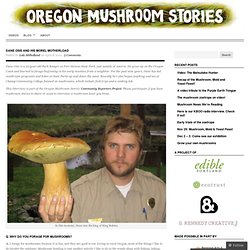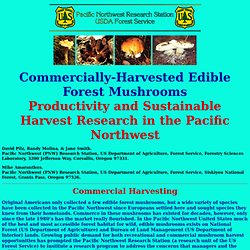

Perfecti. Perfecti. Dane Osis and His Morel Motherload « Oregon Mushroom Stories. Dane Osis and His Morel Motherload Posted by Lola Milholland on April 6, 2012 · 5 Comments Dane Osis is a 35-year-old Park Ranger at Fort Stevens State Park, just outside of Astoria.

He grew up on the Oregon Coast and learned to forage beginning in his early twenties from a neighbor. For the past nine years, Dane has led mushroom programs and hikes at State Parks up and down the coast. Recently he’s also begun teaching courses at Clatsop Community College focused on mushrooms, which include field trips and a cooking lab. This interview is part of the Oregon Mushroom Stories’ Community Reporters Project. In this moment, Dane was the king of King Boletes. Q. A. Q. A. Soon we came to a road and behind it were thousands of acres of charred forest. Shortly after setting up camp we set out on foot to hunt for morels. When I got back to Astoria I had to figure out a way to preserve my cut of the harvest, about 30 lbs of morels. Dane and a hefty cauliflower mushroom.
Q. Central Oregon Mushroom Club. Most Recent Archives. Most Recent Archives (This Year) June 1st, 2007: submitted photos: June 1st, 2007: B-Dodo the estranged, black morel - general location = Oregon, above Parkdale, Growing Conditions = Heavy timber lands about 4000' Additional Comments = A great day on Monday May 28th, 10lbs of Morels, batches of Yellow Corals, 4 giant Gyromirta Gigas and a solitary King Bolete!!!!

The biggest Morels I've ever found in my life!!! Glory be, seems the season is moving to higher elevations. Morels ending bring on the Boletes!!! June 2nd, 2007: Pamela Himmel, morels - general location = Just off my front porch around my tiny pond and under my porch. June 2nd, 2007: Grant County, Oregon at ~ 6500 ft. elevation. June 3rd, 2007; Scott and Michie found a nice batch of morels and five puffballs on June 1st.
June 3rd, 2007: Hello, These are growing in my flower bed. These are not really poisonous, but who would want to eat them with that smell? June 3rd, 2007: Hi- I found my first coral fungus! 2012 Morel Sightings Map. Morel Mushroom Report. The Largest Mushroom Society in the Pacific Northwest. MDCP Morel Taxa. By Michael Kuo The morels described below are based on unpublished DNA testing of morels sent in to the Morel Data Collection Project . I have not used scientific names (with two exceptions), since most of the scientific names currently in use represent European species, and DNA comparisons would have to be made before these European names could be applied to North American mushrooms.
The names used below are either random "taxon" numbers assigned by Dr. Carol Carter or Dr. Kerry O'Donnell, common names I have featured in my book (University of Michigan Press, 2005), or common names featured in other publications. (Carter RFLP Taxon 10; O'Donnell Sequencing Taxon F) This species was described from Mexico by Gastón Guzmán and Fidel Tapia in 1998. The original, type collection (upper-left photo) was made in disturbed ground on a road embankment near the Gulf Coast of Mexico; California specimens have come from landscaping areas--usually in the winter following the landscaping activity. PNW edibles. Edible Forest Mushrooms. Commercially-Harvested Edible Forest Mushrooms Productivity and Sustainable Harvest Research in the Pacific Northwest David Pilz, Randy Molina, & Jane Smith.

Pacific Northwest (PNW) Research Station, US Department of Agriculture, Forest Service, Forestry Sciences Laboratory, 3200 Jefferson Way, Corvallis, Oregon 97331. Mike Amaranthus. Pacific Northwest (PNW) Research Station, US Department of Agriculture, Forest Service, Siskiyou National Forest, Grants Pass, Oregon 97526. Commercial Harvesting Original Americans only collected a few edible forest mushrooms, but a wide variety of species have been collected in the Pacific Northwest since Europeans settled here and sought species they knew from their homelands.
Mushroom companies establish temporary buying stations in local towns during the harvest seasons. Basket of commercially collected Tricholoma magnivelare (American matsutake). Basket of commercially collected Morchella elata group (black morels). Species and Ectomycorrhizae. Edible Wild Mushrooms of the Pacific Northwest.